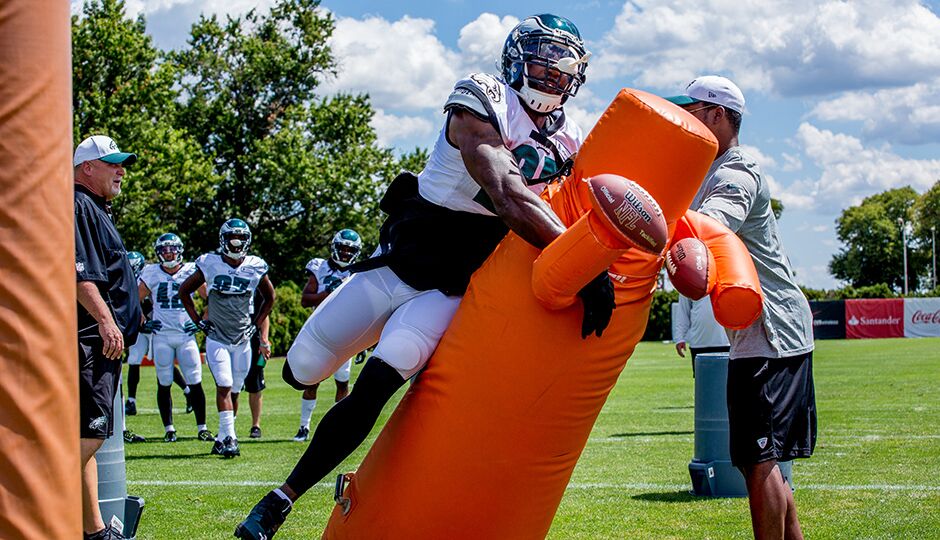Malcolm Jenkins: Preventing Big Plays

Photo by: Jeff Fusco.
Malcolm Jenkins smiles, and then he begins to laugh. A reporter asks why the secondary did a better job of preventing big plays in the preseason compared to last year, and Jenkins looks as if he’s embarrassed to reveal the answer.
“Honestly, the great thing about our front [seven] is they do a good job of keeping the ball off of us,” Jenkins said. “Rarely do we have to fly up and be aggressive in run support. They usually take care of it and give us the ability to focus solely on the pass.”
That’s only the first element, of course, but it’s an important foundation the Eagles’ secondary is trying to build upon. Last season, the Eagles ranked second-to-last in passing yards given up and fourth-to-last in passing touchdowns allowed.
This season, they’ve put an emphasis on not giving up big plays through the air.
Chip Kelly said during the preseason that the secondary is becoming “lactose intolerant,” meaning they don’t bite on the cheese—or play-action passes and underneath routes in front of them—and allow receivers to get behind them. Jenkins, however, likes to instead use a tree metaphor to explain how he predicts plays and prevents long passes.
“I have a tree full of plays they can run in my mind,” Jenkins said. “I can knock off branches knowing what they won’t do so I have two or three options left of what the play could be.”
According to the safety, he eliminates about 90 percent of the offense’s options before the play fully develops. Jenkins starts to take branches off the tree before the game even starts by studying film. He’s already thinking about what the Falcons will likely run in certain situations.
“With the offensive coordinator they have, they’ll be in a lot of two running back formations on first and second down,” Jenkins said. “They’ll run the stretches, but then they’ll run bootlegs off that same stretch action. They like to do a lot of play-action pass and take some shots down the field.”
To determine whether the opponent will attempt one of those big plays, Jenkins starts analyzing the offense while they’re in the huddle. He looks at the personnel and what the formation will likely be before they line up.
Once the formation is set, Jenkins looks at the offense’s splits and how they’re aligned.
“If I’m covering and I know off of one split they have three routes and all of a sudden there’s a play-action,” he said, “I know the shortest route is eliminated because if it’s play-action, it’s probably going to be a deeper route.”
Before the ball is snapped, Jenkins also communicates with a linebacker. Although the inside linebacker tells him—and the rest of the unit—what defense they’re running, Jenkins responds and sets the coverage. He communicates the secondary’s assignments and who is supposed to work together on the back end.
When the ball is snapped, Jenkins often looks at an uncovered lineman to diagnose if the play is a run or pass. If he’s in man-to-man coverage, he locks in on his man and reads how the receiver comes off the ball.
“If it’s an inside release, I’m thinking inside breaking routes like a curl, dig or post,” Jenkins said. “Or if it’s an outside release I may be thinking it’s a fade.”
The quarterback also supplies clues to help Jenkins knock branches off his tree.
“If he takes a three-step drop, we know the routes are going to be quick whether it’s a slant, out or hitch so we’re a lot more aggressive,” he said. “If the quarterback clears the three-step and now it’s a five-step drop, now we’re thinking more intermediate routes like digs, deep outs and curls. Play-action is telling me he’s going deep so it will be the post or a route down the field.”
Because these reads are so important, Jenkins explained that one of the biggest elements in preventing big plays is eye discipline. He noted that he does think the secondary has improved on not giving up long passes—although there is still more room to grow—and that better eye discipline is a significant reason why.
“It’s about practice because you have to get in the habit of putting your eyes in the right place,” Jenkins said. “When you start looking at too many things, you’ll start seeing the play-action. Even though your read is telling you it’s a pass, you see the quarterback fake the ball and it brings you up and all of a sudden someone is behind you.
“Your eyes have to be in the right spot only reading what you’re supposed to be reading. Once you get that rhythm of where your eyes go throughout the play, it makes it a lot easier to put yourself in a position to make a play.”